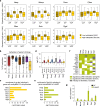A comparative methylome analysis reveals conservation and divergence of DNA methylation patterns and functions in vertebrates
- PMID: 35317801
- PMCID: PMC8941758
- DOI: 10.1186/s12915-022-01270-x
A comparative methylome analysis reveals conservation and divergence of DNA methylation patterns and functions in vertebrates
Abstract
Background: Cytosine DNA methylation is a heritable epigenetic mark present in most eukaryotic groups. While the patterns and functions of DNA methylation have been extensively studied in mouse and human, their conservation in other vertebrates remains poorly explored. In this study, we interrogated the distribution and function of DNA methylation in primary fibroblasts of seven vertebrate species including bio-medical models and livestock species (human, mouse, rabbit, dog, cow, pig, and chicken).
Results: Our data highlight both divergence and conservation of DNA methylation patterns and functions. We show that the chicken genome is hypomethylated compared to other vertebrates. Furthermore, compared to mouse, other species show a higher frequency of methylation of CpG-rich DNA. We reveal the conservation of large unmethylated valleys and patterns of DNA methylation associated with X-chromosome inactivation through vertebrate evolution and make predictions of conserved sets of imprinted genes across mammals. Finally, using chemical inhibition of DNA methylation, we show that the silencing of germline genes and endogenous retroviruses (ERVs) are conserved functions of DNA methylation in vertebrates.
Conclusions: Our data highlight conserved properties of DNA methylation in vertebrate genomes but at the same time point to differences between mouse and other vertebrate species.
Keywords: 5mC; CpG island; DNA methylation; Genomic imprinting; Germline genes; Vertebrates.
© 2022. The Author(s).
Conflict of interest statement
The authors declare that they have no competing interests.
Figures






Similar articles
-
Conserved and divergent patterns of DNA methylation in higher vertebrates.Genome Biol Evol. 2014 Oct 28;6(11):2998-3014. doi: 10.1093/gbe/evu238. Genome Biol Evol. 2014. PMID: 25355807 Free PMC article.
-
Cross-species examination of X-chromosome inactivation highlights domains of escape from silencing.Epigenetics Chromatin. 2021 Feb 17;14(1):12. doi: 10.1186/s13072-021-00386-8. Epigenetics Chromatin. 2021. PMID: 33597016 Free PMC article.
-
Epigenetic conservation at gene regulatory elements revealed by non-methylated DNA profiling in seven vertebrates.Elife. 2013 Feb 26;2:e00348. doi: 10.7554/eLife.00348. Elife. 2013. PMID: 23467541 Free PMC article.
-
Patterns of DNA methylation in animals: an ecotoxicological perspective.Integr Comp Biol. 2014 Jul;54(1):77-86. doi: 10.1093/icb/icu025. Epub 2014 Apr 29. Integr Comp Biol. 2014. PMID: 24785828 Review.
-
DNA methylation in amphioxus: from ancestral functions to new roles in vertebrates.Brief Funct Genomics. 2012 Mar;11(2):142-55. doi: 10.1093/bfgp/els009. Epub 2012 Mar 2. Brief Funct Genomics. 2012. PMID: 22389042 Review.
Cited by
-
DNA methylation patterns and predictive models for metabolic disease risk in offspring of gestational diabetes mellitus.Diabetol Metab Syndr. 2025 May 2;17(1):147. doi: 10.1186/s13098-025-01707-7. Diabetol Metab Syndr. 2025. PMID: 40312441 Free PMC article.
-
Comprehensive Analysis of Methylome and Transcriptome to Identify Potential Genes Regulating Porcine Testis Development.Int J Mol Sci. 2024 Aug 22;25(16):9105. doi: 10.3390/ijms25169105. Int J Mol Sci. 2024. PMID: 39201790 Free PMC article.
-
Endogenous Retroviruses (ERVs): Does RLR (RIG-I-Like Receptors)-MAVS Pathway Directly Control Senescence and Aging as a Consequence of ERV De-Repression?Front Immunol. 2022 Jun 9;13:917998. doi: 10.3389/fimmu.2022.917998. eCollection 2022. Front Immunol. 2022. PMID: 35757716 Free PMC article. Review.
-
Genome skimming with nanopore sequencing precisely determines global and transposon DNA methylation in vertebrates.Genome Res. 2023 Jun;33(6):948-956. doi: 10.1101/gr.277743.123. Epub 2023 Jul 13. Genome Res. 2023. PMID: 37442577 Free PMC article.
-
Regulatory and evolutionary impact of DNA methylation in two songbird species and their naturally occurring F1 hybrids.BMC Biol. 2024 May 29;22(1):124. doi: 10.1186/s12915-024-01920-2. BMC Biol. 2024. PMID: 38807214 Free PMC article.
References
Publication types
MeSH terms
LinkOut - more resources
Full Text Sources
Molecular Biology Databases
Research Materials

